List of plants used in herbalism
This article may present appropriate weight to the mainstream view and explaining the responses to the fringe theories. (September 2017) ) |
This article needs more primary sources. (September 2017) |  |
| This article is part of a series on |
| Alternative medicine |
|---|
 |
This is an alphabetical list of plants used in herbalism.
Phytochemicals possibly involved in biological functions are the basis of herbalism, and may be grouped as:
- primary metabolites, such as carbohydrates and fats found in all plants
- secondary metabolites serving a more specific function.[1]
For example, some secondary metabolites are toxins used to deter predation, and others are pheromones used to attract insects for pollination. Secondary metabolites and pigments may have therapeutic actions in humans, and can be refined to produce drugs; examples are quinine from the cinchona, morphine and codeine from the poppy, and digoxin from the foxglove.[1]
In Europe,
is the study of plant sources of phytochemicals.Some modern
white willow. The opium poppy is a major industrial source of opiates, including morphine
. Few traditional remedies, however, have translated into modern drugs, although there is continuing research into the efficacy and possible adaptation of traditional herbal treatments.
A
| Scientific name | Common name | Description | Picture |
|---|---|---|---|
Acacia senegal
|
Gum arabic | A natural gum sourced from hardened sap of various species of acacia tree used in ancient birth control as well as a binder and emulsifier for medicinal compounds.[3][4] | 
|
| Achillea millefolium | Common yarrow | Purported to be a . | 
|
| Actaea racemosa | Black cohosh
|
Historically used for arthritis and muscle pain, used more recently for conditions related to menopause and menstruation.[6] | 
|
| Aesculus hippocastanum | Horse chestnut
|
Its seeds, leaves, bark, and flowers have been used medicinally for many centuries for treating joint pain, bladder and gastrointestinal problems, fever, leg cramps, and other conditions. It may be useful for treating chronic venous insufficiency. The raw plant materials are toxic unless processed.[7] | 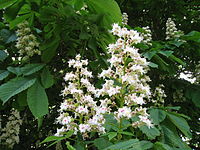
|
| Ageratina altissima | White snakeroot | Root tea has been used to treat tremetol which causes milk sickness, a sometimes fatal condition.[9]
|
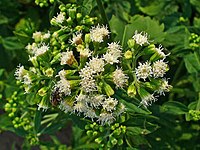
|
| Alcea rosea | Common hollyhock | Believed to be an bedwetting and as a mouthwash in cases of bleeding gums.[10]
|

|
| Alisma plantago-aquatica | Water-plantain | Used for the urinary tract.[11] | 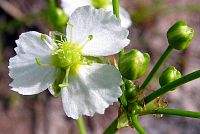
|
Allium sativum
|
Garlic | Purported use to lower blood cholesterol and high blood pressure.[12]
|

|
| Aloe vera | Aloe vera | Leaves are widely used to skin ailments.[13]
|
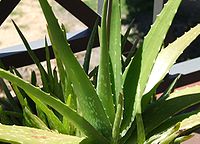
|
| Althaea officinalis | Marsh-mallow
|
Used historically as both a food and a medicine.[2] | 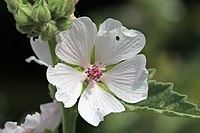
|
Amorphophallus konjac
|
Konjac | Significant dietary source of glucomannan,[14] which is purported for use in treating obesity, constipation,[15] and reducing cholesterol.[16] | 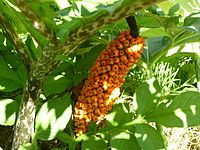
|
| Anemone hepatica | Common hepatica | Historically used to treat liver diseases, it is still used in alternative medicine today. Other modern applications by herbalists include treatments for pimples, bronchitis and gout.[17] | 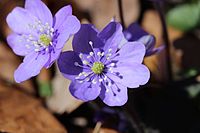
|
| Angelica archangelica | Garden angelica | Roots have been used in the traditional Austrian medicine internally as tea or tincture for treatment of disorders of the gastrointestinal tract, respiratory tract, nervous system, and also against fever, infections, and flu.[18] | 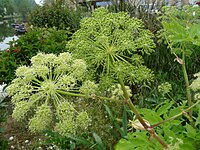
|
| Angelica sinensis | Dong quai
|
Used for thousands of years in Asia, primarily in women's health.[19] | |
Apium graveolens
|
Celery | Seed is used only occasionally in tradition medicine. Modern usage is primarily as a diuretic.[20] | 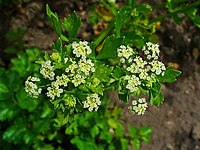
|
| Arctium lappa | Burdock
|
Used traditionally as a diuretic and to lower blood sugar[21] and, in traditional Chinese medicine as a treatment for sore throat and symptoms of the common cold.[22][unreliable source?] | 
|
| Arnica montana | Arnica | Used as an anti-inflammatory[23] and for osteoarthritis.[24] The US Food and Drug Administration has classified Arnica montana as an unsafe herb because of its toxicity.[25] It should not be taken orally or applied to broken skin where absorption can occur.[25] | 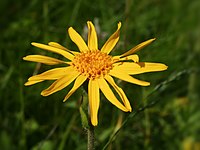
|
Astragalus propinquus
|
Astragalus | Long used in traditional Chinese medicine.[26] | 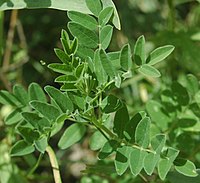
|
| Atropa belladonna | Belladonna | Although toxic, was used historically in Italy by women to enlarge their pupils, as well as a sedative, among other uses. The name itself means "beautiful woman" in Italian.[27] | 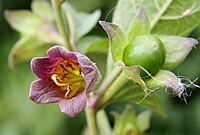
. |
| Azadirachta indica | Neem
|
Used in India to treat worms, malaria, rheumatism and skin infections among many other things. Its many uses have led to neem being called "the village dispensary" in India.[28] | 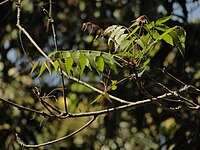
|
B
| Scientific name | Name | Description | Picture |
|---|---|---|---|
| Bellis perennis | Daisy | Flowers have been used in the traditional Austrian medicine internally as tea (or the leaves as a salad) for treatment of disorders of the gastrointestinal and respiratory tract.[18] | 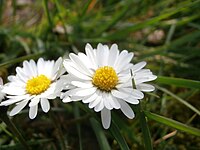
|
| Berberis vulgaris | Barberry
|
Long history of medicinal use, dating back to the gastro-intestinal ailments.[29]
|

|
Borago officinalis
|
Borage | Used in urinary (diuretic and kidney/bladder disorders).[31]
|
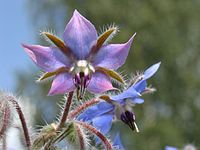
|
Broussonetia kurzii
|
Salae | Known as Salae in Thailand where this species is valued as a medicinal plant.[32]
|
C
| Scientific name | Name | Description | Picture |
|---|---|---|---|
| Calendula officinalis | Marigold | Also named calendula, has a long history of use in treating wounds and soothing skin.[33][self-published source?] | 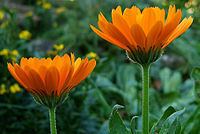
|
| Cannabis | Hemp, Cannabis, Marijuana, Indian hemp, Ganja | Used worldwide since ancient times as treatment for various conditions and ailments including pain, inflammation, gastrointestinal issues such as autism, cancer, cerebral palsy, recurring headaches, Crohn's disease, depression, epilepsy, glaucoma, insomnia, and neuropathy among others.[34]
|
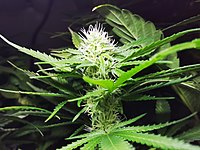
|
| Capsicum annuum | Cayenne | Type of chili that has been used as both food and medicine for thousands of years. Uses have included reducing pain and swelling, lowering triglyceride and cholesterol levels and fighting viruses and harmful bacteria, due to high levels of Vitamin C.[35][36][37] | 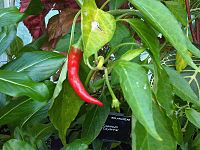
|
| Capsicum frutescens | Chili | Its active ingredient, heart attack in Thais may be related to capsaicine's fibronolytic action (dissolving blood clots).[38]
|

|
Carica papaya
|
Papaya | Used for treating wounds and stomach troubles.[39] | 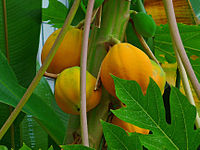
|
Cassia occidentalis
|
Coffee senna
|
Used in a wide variety of roles in traditional medicine, including in particular as a broad-spectrum internal and external antimicrobial, for liver disorders, for intestinal worms and other parasites and as an immune-system stimulant.[40][41] | 
|
Catha edulis
|
Khat | Mild stimulant used for thousands of years in Yemen, and is banned today in many countries. Contains the amphetamine-like substance cathinone.[citation needed] | 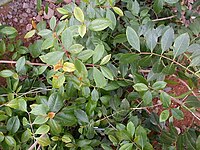
|
| Cayaponia espelina | São Caetano melon | It is a diuretic and aid in the treatment of diarrhea and syphilis.[42] | 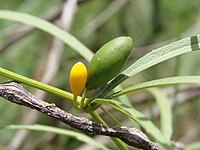
|
| Centaurea cyanus | Cornflower | In herbalism, a decoction of cornflower is effective in treating conjunctivitis and as a wash for tired eyes.[43]
|
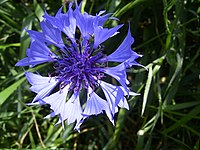
|
| Chrysopogon zizanioides | Vetiver | Used for skin care.[44] | 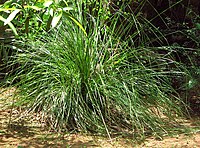
|
| Cinchona spec. | Cinchona | 
| |
Citrus × aurantium
|
Bitter orange | Used in | 
|
Citrus limon
|
Lemon | Along with other citruses, it has a long history of use in Chinese and Indian traditional medicine.[47] In contemporary use, honey and lemon is common for treating coughs and sore throat. | 
|
Citrus trifoliata
|
Trifoliate orange, bitter orange | Fruits of Citrus trifoliata are widely used in Oriental medicine as a treatment for allergic inflammation.[48] | 
|
| Cissampelos pareira | Velvetleaf | Used for a wide variety of conditions.[49] | 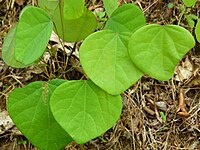
|
Cnicus benedictus
|
Blessed thistle
|
Used during the loss of appetite, indigestion and other purposes.[50]
|
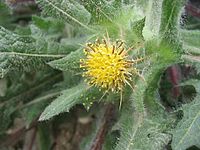
|
| Crataegus monogyna and Crataegus laevigata | Hawthorn | Fruit has been used for centuries purportedly for heart disease, digestive and kidney related problems.[51]
|

|
Curcuma longa
|
Turmeric | Spice that lends its distinctive yellow color to Indian curries, has long been used in Ayurvedic and traditional Chinese medicine to aid digestion and liver function, relieve arthritis pain, and regulate menstruation.[52] | 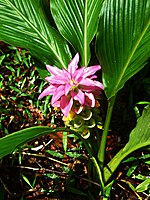
|
| Cypripedium parviflorum | Yellow lady's slipper | The Cypripedium species have been used in native remedies for dermatitis, tooth aches, anxiety, headaches, as an antispasmodic, stimulant and sedative. However, the preferred species for use are Cyp. parviflorum and Cyp.acaule, used as topical applications or tea.[53] | 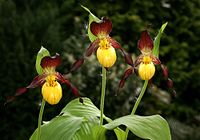
|
D
| Scientific name | Name | Description | Picture |
|---|---|---|---|
| Digitalis lanata | Digitalis or foxglove | It came into use in treating cardiac disease in late 18th century England in spite of its high toxicity.a Its use has been almost entirely replaced by the pharmaceutical derivative Digoxin, which has a shorter half-life in the body, and whose toxicity is therefore more easily managed.[54] Digoxin is used as an antiarrhythmic agent and inotrope.[55]
|
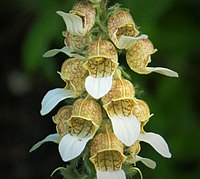
|
E
| Scientific name | Name | Description | Picture |
|---|---|---|---|
| Echinacea purpurea | Purple coneflower
|
This plant and other species of Echinacea have been used for at least 400 years by Native Americans to treat infections and wounds, and as a general "cure-all" (panacea). It is currently used for symptoms associated with cold and flu.[56] | 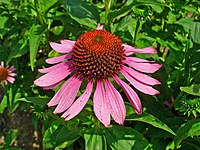
|
Echinopsis pachanoi
|
San Pedro cactus
|
The San Pedro cactus contains the entheogen mescaline and has a long history of being used in Andean traditional medicine.[57] | 
|
| Ephedra sinica | Ephedra | It has been used in traditional Chinese medicine for more than 2,000 years.[58][59] Native Americans and Mormon pioneers drank a tea brewed from other Ephedra species, called "Mormon tea" and "Indian tea". It contains the alkaloids ephedrine and pseudoephedrine, which are used as breathing aids (bronchodilators and decongestants).[60] | 
|
| Equisetum arvense | Horsetail
|
Dates back to ancient Roman and Greek medicine, when it was used to stop bleeding, heal ulcers and wounds, and treat tuberculosis and kidney problems.[61] | 
|
| Eriodictyon crassifolium | Yerba Santa | Used by the Chumash people to keep airways open for proper breathing.[62] The US Forest Service profile[63] for Eriodictyon crassifolium provides information on species distribution; taxonomic relationships; ecological and evolutionary considerations for restoration; growth form and distinguishing traits; habitat characteristics; projected future suitable habitat; growth, reproduction and dispersal; biological interactions; ecological genetics; seed characteristics, germination requirements and processing; and plant uses including agriculture, restoration, and traditional products, plus an extensive bibliography. It is part of Riverside-Corona Resource Conservation District's resource materials collection on native plant recommendations for southern California ecoregions. | 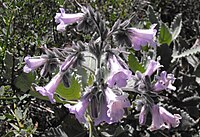
|
| Erythroxylum coca | Coca | Used as coca tea or chewed, traditionally as a stimulant to overcome fatigue, hunger, thirst, and altitude sickness.[64] Also used as an anesthetic and analgesic.[65] | 
|
| Eschscholzia californica | Californian poppy | Used as a | 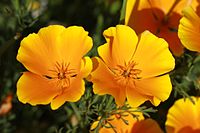
|
| Eucalyptus globulus | Eucalyptus | Leaves were widely used in traditional medicine as a | 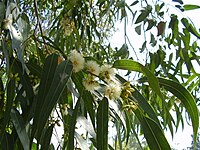
|
| Euonymus atropurpureus | Wahoo | Plant is a purgative and might affect the heart.[69] | |
| Euphorbia hirta | Asthma-plant
|
Used traditionally in Asia to treat bronchitic asthma and laryngeal spasm.[70][71] It is used in the Philippines for dengue fever.[72] | 
|
| Euphrasia | Eyebright
|
Used for eye problems, mental depression, oxygenation and radiation poisoning.[73] | 
|
Euterpe oleracea
|
Açai
|
Although açai berries are a longstanding food source for indigenous people of the Amazon, there is no evidence that they have effectiveness for any health-related purpose.[74] |
F
| Scientific name | Name | Description | Picture |
|---|---|---|---|
| Ferula assa-foetida | Asafoetida | Might be useful for IBS, high cholesterol, and breathing problems.[75] | |
| Frangula alnus | Alder buckthorn | Bark (and to a lesser extent the fruit) has been used as a anthraquinone content. Bark for medicinal use is dried and stored for a year before use, as fresh bark is violently purgative; even dried bark can be dangerous if taken in excess.[76]
|

|
| Fumaria officinalis | Fumitory | Traditionally thought to be good for the eyes and to remove skin skin diseases and conjunctivitis, as well as to cleanse the kidneys. However, Howard (1987) warns that fumitory is poisonous and should only be used under the direction of a medical herbalist.[77]
|

|
G
| Scientific name | Name | Description | Picture |
|---|---|---|---|
| Galanthus | Snowdrop
|
It contains an active substance called galantamine, which is an acetylcholinesterase inhibitor. Galantamine (or galanthamine) can be helpful in the treatment of Alzheimer's disease, though it is not a cure.[78] | 
|
| Geranium robertianum | Robert geranium | In traditional vulnerary (used for or useful in healing wounds).[80]
|
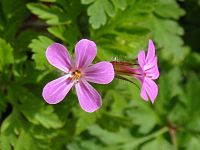
|
| Ginkgo biloba | Ginkgo | The leaf extract has been used to treat | 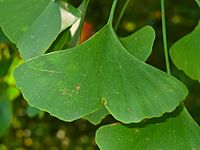
|
| Glechoma hederacea | Ground-ivy | It has been used as a "lung herb".. | 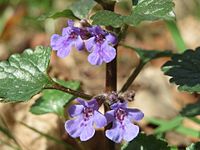
|
Glycyrrhiza glabra
|
Licorice root
|
Purported uses include |
H
| Scientific name | Name | Description | Picture |
|---|---|---|---|
| Hamamelis virginiana | Common witch-hazel | It produces a specific kind of tannins called colon cancer cells.[85]
|

|
| Hippophae rhamnoides | Sea buckthorn
|
The leaves are used as herbal medicine to alleviate cough and fever, pain, and general gastrointestinal disorders as well as to cure dermatologic disorders. Similarly, the fruit juice and oils can be used in the treatment of liver disease, gastrointestinal disorders, chronic wounds or other dermatological disorders.[86] | 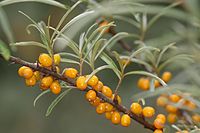
|
| Hoodia gordonii | Hoodia | The plant is traditionally used by appetite suppressant.[87]
|

|
Hydrastis canadensis
|
Goldenseal | Although used traditionally by skin diseases and ulcers, there is no scientific evidence to support the use of goldenseal for treating any disease.[88]
|

|
| Hypericum perforatum | St. John's wort
|
Widely used within herbalism for depression. Evaluated for use as an antidepressant, but with ambiguous results.[89][90] | 
|
| Hyssopus officinalis | Hyssop | It is purported for digestive and intestinal problems, and for respiratory problems.[91] | 
|
I
| Scientific name | Name | Description | Picture |
|---|---|---|---|
Ilex paraguariensis
|
Yerba mate | Mate contains compounds that may improve mood.[92] | 
|
| Illicium verum | Star anise
|
It is the major source of the chemical compound shikimic acid, a primary precursor in the pharmaceutical synthesis of anti-influenza drug oseltamivir (Tamiflu).[93] | 
|
Inula helenium
|
Elecampane | It is used in water retention.[94]
|
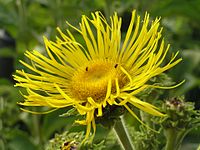
|
J
| Scientific name | Name | Description | Picture |
|---|---|---|---|
| Jasminum officinale | Jasmine | It is purported as either an antiseptic or anti-inflammatory agent.[95] | 
|
K
| Scientific name | Name | Description | Picture |
|---|---|---|---|
| Knautia arvensis | Field scabious | The whole plant is astringent and mildly diuretic.[96] | 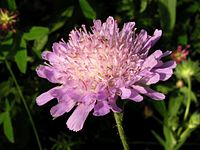
|
L
| Scientific name | Name | Description | Picture |
|---|---|---|---|
| Larrea tridentata | Chaparral | The leaves and twigs are used by Native Americans to make a herbal tea used for a variety of conditions. Chaparral has also been shown to have high liver toxicity, and has led to kidney failure, and is not recommended for any use by the U.S. Food and Drug Administration or American Cancer Society.[97][98] | 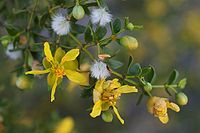
|
| Laurus nobilis | Bay laurel | Aqueous extracts of bay laurel can be used as astringents and even as a reasonable salve for open wounds.[99] | 
|
| Lavandula angustifolia | Lavender
|
It was traditionally used as an antiseptic and for mental health purposes. It was also used in ancient Egypt in mummifying bodies. There is little scientific evidence that use of lavender affects health.[100] | 
|
| Lawsonia inermis | Henna | 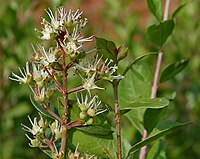
| |
| Leucojum aestivum | Summer snowflake | 
| |
Linum usitatissimum
|
Flaxseed
|
The plant is most commonly used as a | 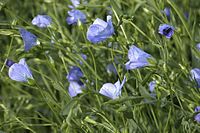
|
M
| Scientific name | Name | Description | Picture |
|---|---|---|---|
| Magnolia officinalis | Magnolia-bark | The bark contains magnolol and honokiol, two polyphenolic compounds. | 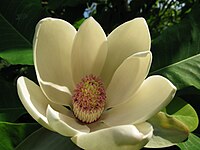
|
| Malva sylvestris | Mallow | The seeds are used internally in a emollient for external applications.
|
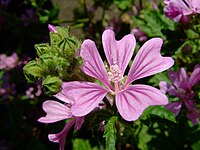
|
Anthemis nobilis
|
Chamomile | It has been used over history for a variety of conditions, including sleeplessness and anxiety.[103] | 
|
Medicago sativa
|
Alfalfa | The leaves are purported to lower urinary tract ailments, although there is insufficient scientific evidence for its efficacy.[104]
|

|
| Melaleuca alternifolia | Tea tree oil | It has been used over history by Australian aboriginal people. Modern usage is primarily as an antifungal agent, but there is insufficient scientific evidence for such effects.[105]
|

|
Melissa officinalis
|
Lemon balm | It is purported as a sleep aid and digestive aid.[106] | 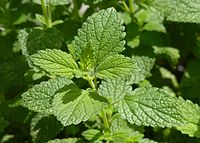
|
Mentha x piperita
|
Peppermint | Its oil, from a cross between water mint and spearmint, has a history of purported use for various conditions, including nausea, indigestion, and symptoms of the common cold.[107]
|

|
| Mitragyna speciosa | Kratom
|
Kratom leaves are chewed to relieve musculoskeletal pain and increase energy, appetite, and sexual desire in ways similar to khat and coca.[108] | 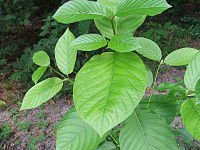
|
| Momordica charantia | Bitter melon
|

| |
| Morinda citrifolia | Noni
|
It is purported for joint pain and skin conditions.[109]
|
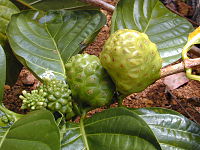
|
| Moringa oleifera | Drumstick tree | It is used for food and traditional medicine.[citation needed] | 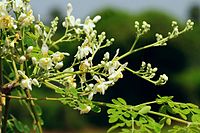
|
N
| Scientific name | Name | Description | Picture |
|---|---|---|---|
Nasturtium officinale
|
Watercress | 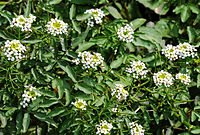
| |
| Nelumbo nucifera | Lotus | Insufficient evidence for any biological effect.[110] | 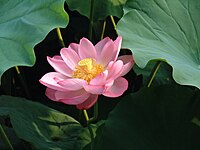
|
| Nigella sativa | Nigella, black-caraway, black-cumin, and kalonji | One meta-analysis of clinical trials concluded that N. sativa has a short-term benefit on lowering diastolic blood pressure.[111]
|
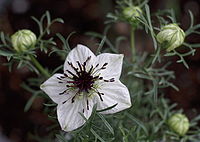
|
O
| Scientific name | Name | Description | Picture | |
|---|---|---|---|---|
| Ocimum tenuiflorum | Tulsi or holy basil | It is used for a variety of purposes in traditional medicine; tulsi is taken in many forms: as herbal tea, dried powder, fresh leaf or mixed with ghee. Essential oil extracted from Karpoora tulasi is mostly used for medicinal purposes and in herbal cosmetics.[112] | 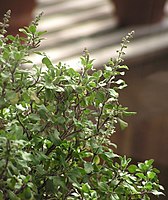
| |
| Oenothera | Evening primrose
|
Its eczema, and more recently as an anti-inflammatory, but there is insufficient evidence for it having any effect.[113]
|
||
Origanum vulgare
|
Oregano | 
|
P
| Scientific name | Name | Description | Picture |
|---|---|---|---|
| Panax spec. | Ginseng | Asian ginseng may affect glucose metabolism and lower blood sugar levels, but the poor quality of research prevents conclusions about such effects.[114] | 
|
| Papaver somniferum | Opium poppy
|
The plant is the plant source of morphine, used for pain relief. Morphine made from the refined and modified sap is used for pain control in people with severe cancer.[115] | 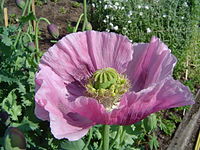
|
| Passiflora | Passion flower
|
|
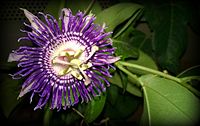
|
| Peganum harmala | Harmal )
|
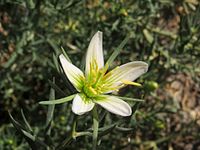
| |
| Pelargonium sidoides | South African Geranium
|
Possibly useful for treating respiratory infections.[116] | 
|
Piper methysticum
|
Kava | The plant has been used for centuries in the South Pacific to make a ceremonial drink with sedative and anesthetic properties, with potential for causing liver injury.[117] | 
|
Piscidia erythrina / Piscidia piscipula
|
Jamaica dogwood
|
The plant is used in traditional medicine for the treatment of insomnia and anxiety, despite serious safety concerns.[118] A 2006 study suggested medicinal potential.[119] | |
| Plantago lanceolata | Plantain | It is used frequently in herbal remedies.[120] A tea from the leaves is used as a highly effective cough medicine. In the traditional Austrian medicine Plantago lanceolata leaves have been used internally (as syrup or tea) or externally (fresh leaves) for treatment of disorders of the respiratory tract, skin, insect bites, and infections.[18]
|
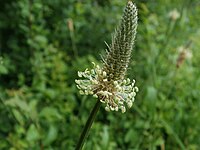
|
Platycodon grandiflorus
|
Platycodon, balloon flower | The extracts and purified platycoside compounds ( saponins) from the roots may exhibit neuroprotective, antimicrobial, anti-inflammatory, anti-cancer, anti-allergy, improved insulin resistance, and cholesterol-lowering properties.[121]
|

|
| Polemonium reptans | Abscess root | It is used to reduce fever, inflammation, and cough.[122] | 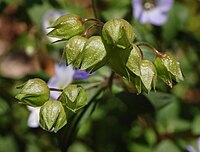
|
| Psidium guajava | Guava | It has a rich history of use in traditional medicine. It is traditionally used to treat diarrhea; however, evidence of its effectiveness is very limited.[123][124] | 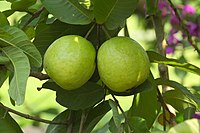
|
| Ptelea trifoliata | Wafer Ash | The root bark is used for the digestive system.[125] Also known as hoptree. | 
|
| Pulmonaria officinalis | Lungwort
|
Used since the Middle Ages to treat and/or heal various ailments of the lungs and chest.[citation needed] | 
|
Q
| Scientific name | Name | Description | Picture |
|---|---|---|---|
| Quassia amara | Amargo, bitter-wood | A 2012 study found a topical gel with 4% Quassia extract to be a safe and effective cure of rosacea.[126] | 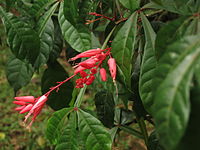
|
R
| Scientific name | Name | Description | Picture |
|---|---|---|---|
| Reichardia tingitana | False sowthistle | Uses in folk medicine have been recorded in the Middle East, its leaves being used to treat ailments such as constipation, colic and inflamed eyes.[127] | 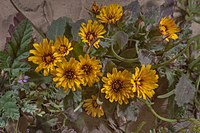
|
| Rosa majalis | Cinnamon rose | It yields edible hip fruits rich in vitamin C, which are used in medicine[128] and to produce rose hip syrup. | 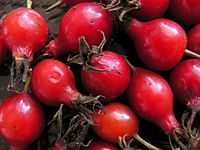
|
Rosmarinus officinalis
|
Rosemary | It has been used medicinally from ancient times.[citation needed] | 
|
| Ruellia tuberosa | Minnieroot, fever root, snapdragon root | In folk medicine and Ayurvedic medicine it has been used as a | 
|
| Rumex crispus | Curly dock or yellow dock | In Western herbalism the root is often used for treating anemia, due to its high level of iron.[130] The plant will help with skin conditions if taken internally or applied externally to things like itching, scrofula, and sores. It is also used for respiratory conditions, specifically those with a tickling cough that is worse when exposed to cold air. It mentions also passing pains, excessive itching, and that it helps enlarged lymphs.[131] | 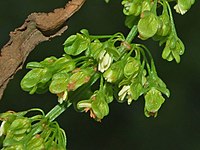
|
S
| Scientific name | Name | Description | Picture |
|---|---|---|---|
| Salix alba | White willow
|
Plant source of stomach upset as a side effect than aspirin itself which can cause the lining of the stomach to be destroyed. Used from ancient times for the same uses as aspirin.[132]
|

|
| Salvia officinalis | Sage | Shown to improve cognitive function in patients with mild to moderate Alzheimer's disease.[133][134] | 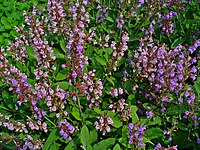
|
| Sambucus nigra | Elderberry
|
The berries and leaves have traditionally been used to treat sinus infections.[135]
|

|
| Santalum album | Indian sandalwood
|
Sandalwood oil has been widely used in folk medicine for treatment of | 
|
| Santolina chamaecyparissus | Cotton lavender | Most commonly, the flowers and leaves are made into a intestinal parasites.[citation needed ]
|

|
| Saraca indica | Ashoka tree | The plant is used in Ayurvedic traditions to treat gynecological disorders. The bark is also used to combat oedema or swelling.[137] | 
|
Satureja hortensis
|
Summer savory | Its extracts show antibacterial and antifungal effects on several species including some of the antibiotic resistant strains.[138][139][140] | 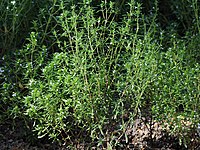
|
Sceletium tortuosum
|
Kanna | African treatment for depression. Suggested to be an SSRI or have similar effects, but unknown mechanism of activity.[citation needed] | 
|
| Senna auriculata | Avaram senna | The root is used in fevers, diabetes, diseases of urinary system and constipation. The leaves have laxative properties. The dried flowers and flower buds are used as a substitute for tea in case of diabetes patients. The powdered seed is also applied to the eye, in case of chronic purulent conjunctivitis.[citation needed ]
|
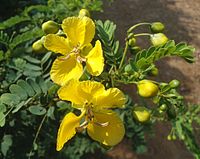
|
| Sesuvium portulacastrum | Shoreline purslane | The plant extract showed antibacterial and anticandidal activities and moderate antifungal activity.[141]
|
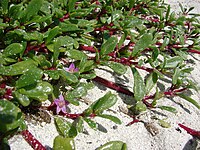
|
| Silybum marianum | Milk thistle
|
It has been used for thousands of years for a variety of medicinal purposes, in particular liver problems.[142] | 
|
| Stachytarpheta cayennensis | Blue snakeweed | Extracts of the plant are used to ease the symptoms of diabetes in Peru and other areas.[144] Laboratory tests indicate that the plant has anti-inflammatory properties.[145]
|
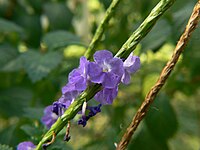
|
| Stellaria media | Common chickweed | It has been used as a remedy to treat itchy skin conditions and period pain.[147]
|

|
Strobilanthes callosus
|
Karvy | The plant is anti-inflammatory, antimicrobial,[148] and anti-rheumatic.[149] | 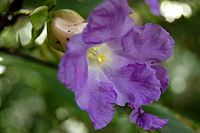
|
| Symphytum officinale | Comfrey
|
It has been used as a vulnerary and to reduce inflammation.[150] It was also used internally in the past, for stomach and other ailments, but its toxicity has led a number of other countries, including Canada, Brazil, Australia, and the United Kingdom, to severely restrict or ban the use of comfrey.[151]
|

|
Syzygium aromaticum
|
Clove | The plant is used for upset stomach and as an | 
|
T
| Scientific name | Name | Description | Picture |
|---|---|---|---|
| Tanacetum parthenium | Feverfew | The plant has been used for centuries for insect bites and other conditions.[153]
|

|
| Taraxacum officinale | Dandelion
|
It was most commonly used historically to treat liver diseases, kidney diseases, and spleen problems.[154] | 
|
| Teucrium scordium | Water germander | It has been used for asthma, diarrhea, fever, intestinal parasites, hemorrhoids, and wounds.[155] | 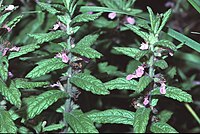
|
| Thymus vulgaris | Thyme | The plant is used to treat expectorant in this role. It has also been used in many other medicinal roles in Asian and Ayurvedic medicine, although it has not been shown to be effective in non-respiratory medicinal roles.[156]
|
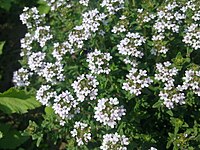
|
| Tilia cordata | Small-leaved linden | In the countries of Central, Southern and Western Europe, linden flowers are a traditional herbal remedy made into a herbal tea called tisane.[157]
|

|
| Tradescantia zebrina | Inchplant | It is used in southeast Mexico in the region of Tabasco as a cold herbal tea, which is named Matali.[158] Skin irritation may result from repeated contact with or prolonged handling of the plant, particularly from the clear, watery sap (a characteristic unique to T. zebrina as compared with other types). | 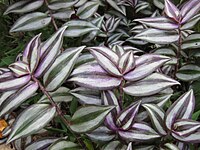
|
Trema orientalis
|
Charcoal-tree | The leaves and the bark are used to treat coughs, sore throats, asthma, bronchitis, gonorrhea, yellow fever, toothache, and as an antidote to general poisoning.[159] | 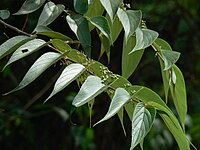
|
| Trifolium pratense | Red clover
|
The plant is an ingredient in some recipes for essiac tea. Research has found no benefit for any human health conditions.[160] | 
|
Trigonella foenum-graecum
|
Fenugreek | It has long been used to treat symptoms of loss of appetite and other conditions.[161]
|
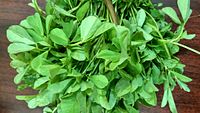
|
| Triticum aestivum | Wheatgrass | It may contain antioxidant and anti-inflammatory compounds.[162] | 
|
| Turnera subulata | White buttercup | It is used for skin, gastrointestinal, and respiratory ailments.[citation needed] | 
|
U
| Scientific name | Name | Description | Picture |
|---|---|---|---|
| Uncaria tomentosa | Cat's claw | It has a long history of use in South America to prevent and treat disease.[163] | |
| Urtica dioica | Common nettle, stinging nettle | It has been used in the traditional Austrian medicine internally (as tea or fresh leaves) to treat disorders of the kidneys and urinary tract, gastrointestinal tract, locomotor system, skin, cardiovascular system, hemorrhage, influenza, rheumatism, and gout.[18] | 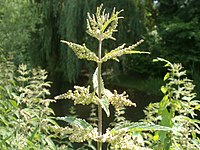
|
V
| Scientific name | Name | Description | Picture |
|---|---|---|---|
| Vaccinium spec. | Blueberries
|
They are of current medical interest as an urinary tract ailments.[166]
|

|
| Vaccinium macrocarpon | Cranberry | It was used historically as a urinary tract related problems.[167]
|
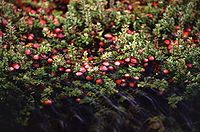
|
| Vaccinium myrtillus | Bilberry | It is used to treat diarrhea, scurvy, and other conditions.[168] | 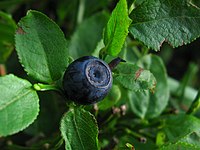
|
Valeriana officinalis
|
Valerian | It has been used since at least ancient Greece and Rome for sleep disorders and anxiety.[169] | 
|
| Verbascum thapsus | Common mullein | It contains tumoral action. These compounds are concentrated in the flowers.[170]
|

|
| Verbena officinalis | Verbena | It is used for sore throats and respiratory tract diseases.[171] | 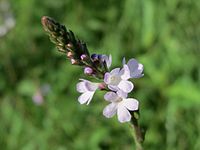
|
| Vernonia amygdalina | Bitter leaf
|
The plant is used by both primates and indigenous peoples in Africa to treat intestinal ailments such as dysentery.[172][173] | 
|
| Veronica officinalis | Veronica | The plant is used for sinus and ear infections.[174] | 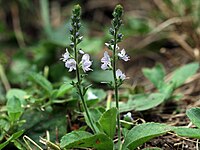
|
| Viburnum tinus | Laurustinus | V. tinus has medicinal properties. The active ingredients are viburnin (a substance or more probably a mixture of compounds) and tannins. Tannins can cause stomach upset. The leaves when infused have antipyretic properties. The fruits have been used as purgatives against constipation. The tincture has been used lately in herbal medicine as a remedy for depression. The plant also contains iridoid glucosides.[175] | 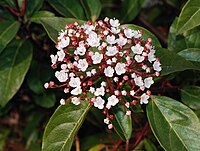
|
| Viola tricolor | Wild pansy | It is one of many viola plant species containing | 
|
| Viscum album | European mistletoe
|
It has been used to treat seizures, headaches, and other conditions.[178] | 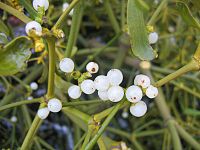
|
| Vitex agnus-castus | Chasteberry
|
It has been used for over thousands of years for menstrual problems, and to stimulate lactation.[179] | 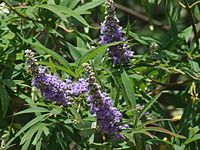
|
| Vitis vinifera | Grape | The leaves and fruit have been used medicinally since the ancient Greeks.[180] | 
|
W
| Scientific name | Name | Description | Picture |
|---|---|---|---|
| Withania somnifera | Ashwagandha | The plant's long, brown, tuberous roots are used in traditional medicine. In Ayurveda, the berries and leaves are applied externally to tumors, tubercular glands, carbuncles, and ulcers.[181] | 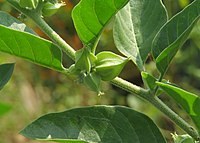
|
X
| Scientific name | Name | Description | Picture |
|---|---|---|---|
| Xanthoparmelia scabrosa | Sexy footpath lichen | It is a lichen used for sexual dysfunction.[182] | 
|
Y
| Scientific name | Name | Description | Picture |
|---|---|---|---|
| Youngia japonica | Japanese hawkweed | The plant is | 
|
Z
| Scientific name | Name | Description | Picture |
|---|---|---|---|
Zingiber officinale
|
Ginger | Ginger is effective for the relief of nausea.[184][185] | 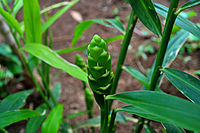
|
Databases
- Manhã EM, Silva MC, Alves MG, Almeida MB, Brandão MG (October 3, 2008). "PLANT - A bibliographic database about medicinal plants". Revista Brasileira de Farmacognosia. 18 (4): 614–617. .
- Duke J. "Dr. Duke's Phytochemical and Ethnobotanical Databases". Retrieved 2011-09-29.
- "Protabase: Useful Plants of Tropical Africa". Plant Resources of Tropical Africa. Archived from the original on 2011-12-16. Retrieved 2011-09-29.
{{cite web}}: External link in|publisher= - "Tropical Plant Database". Raintree. Retrieved 2011-10-18.
- "Plant Database". Plants for a Future. Retrieved 2011-10-18.
- "Vitamins & Supplements Center". WebMD. Retrieved 2021-10-01.
See also
- Chinese classic herbal formula
- History of birth control
- List of branches of alternative medicine
- List of culinary herbs and spices
- List of herbs with known adverse effects
- Materia Medica
- Medicinal mushrooms
- Medicinal plants of the American West
- Medicinal plants traditionally used by the indigenous peoples of North America
- Naturopathic medicine
- Wikispecies
Notes
- ^ Digitalis use in the United States is controlled by the U.S. Food and Drug Administration and can only be prescribed by a physician. Misuse can cause death.
- This encyclopedia is not a substitute for medical advice nor a complete description of these herbs, their dangers (up to and including death), and their (in)compatibility with alcohol or other drugs.
References
- ^ ISBN 9781587160837.
- ^ ISBN 978-1-930513-49-5.
- ISSN 0268-005X.
- ISBN 978-0-19-928564-8.
- ISBN 978-0-87773-639-4.
- ^ "Black cohosh". National Center for Complementary and Integrative Health. 1 May 2020.
- ^ "Horse chestnut". National Center for Complementary and Integrative Health. 1 October 2020.
- ^ "Medicinal Plants-White Snakeroot". Bio.brandeis.edu. Archived from the original on 2013-10-23. Retrieved 2013-11-05.
- ^ "Milk Sickness". National Park Service. Retrieved 22 May 2020.
- ^ Howard, Michael. Traditional Folk Remedies (Century, 1987) p.155
- ^ "Water Plantain". WebMD. Archived from the original on 2015-04-25.
- ^ "Garlic". National Center for Complementary and Integrative Health. 1 December 2020.
- ^ "Aloe Vera". National Center for Complementary and Integrative Health. 1 August 2020.
- PMID 9109608.
- PMID 2547312.
- ^ "Glucomannan". Drugs.com. 23 May 2022. Retrieved 28 October 2022.
- ^ Howard, Michael. Traditional Folk Remedies (Century, 1987); p.161–2
- ^ PMID 23770053.
- ^ "Dong quai (Angelica sinensis [Oliv.] Diels)". Mayo Clinic. Archived from the original on 2011-10-06. Retrieved 2011-10-18.
- )
- ^ "Burdock". Memorial Sloan-Kettering Cancer Center. Archived from the original on 2011-10-29. Retrieved 2011-10-18.
- ^ "Burdock (niu bang zi)". Herbs & Botanical. Naturopathy Digest. Archived from the original on 2012-04-25. Retrieved 2011-10-18.
- S2CID 23328433.
- S2CID 21078244.
- ^ a b "Arnica". drugs.com. Archived from the original on 2017-01-08.
- ^ "Astragalus". National Center for Complementary and Integrative Health. 1 August 2020.
- National Institute of Health MedlinePlus. 14 July 2022.
- ^ Ganguli S (June 10, 2002). "Neem: A therapeutic for all seasons" (PDF). Current Science. 82 (11). Archived (PDF) from the original on June 5, 2011.
- ^ "Barberry". Drugs.com. Archived from the original on 2012-06-20. Retrieved 2011-10-18.
- PMID 17900837.
- ^ Gilani A.H. "Focused Conference Group: P16 - Natural products: Past and future? Pharmacological use of borago officinalis", Basic and Clinical Pharmacology and Toxicology. Conference: 16th World Congress of Basic and Clinical Pharmacology. WorldPharma 2010 Copenhagen Denmark. Publication: (var. pagings). 107 (pp 301), 2010. Date of Publication: July 2010.
- ^ "qsbgplant-db". QSBG Database. Archived from the original on 2017-02-02.
- ^ "Calendula: Herbal Remedies". Discovery Fit & Health. Archived from the original on 2012-04-25.
- ^ "Your Guide to the Top 71 Medical Uses of Cannabis". Green Flower Media. Retrieved 2019-03-17.
- ^ Kremer R (2007). "Ancient Americans liked it hot – Smithsonian study traces Mexican cuisine roots to 1,500 years ago". The Analyst Magazine. Archived from the original on 2012-04-25.
- ^ Tso Y, Love B, Ibañez RC, Ross J. "Capsicum spp". Medicinal Plants of the Southwest. Archived from the original on 2008-05-15.
- ISBN 978-0879837037.
- PMID 7081126.
- PMID 19041705.
- ^ Francis JK. "Senna occidentalis (L.) Link" (PDF). International Institute of Tropical Forestry. Archived (PDF) from the original on 2010-11-22. Retrieved 2011-10-17.
- ^ "Tropical Plant Database". Raintree Nutrition. Archived from the original on 2011-10-27. Retrieved 2011-10-17.
- ISBN 978-0-8493-1187-1.
- ^ Howard M (1987). Traditional Folk Remedies. Century.
- ^ "Vetiver". WebMD. Archived from the original on 2015-04-25. Retrieved 2015-04-06.
- ^ Remington JP, Wood HC, eds. (1918). "Cinchona". The Dispensatory of the United States of America.
- ^ "Bitter orange". National Center for Complementary and Integrative Health. 1 May 2020.
- ISBN 978-0-415-28491-2.
- PMID 17662711.
- ^ "Abuta". WebMD. Archived from the original on 2015-03-18. Retrieved 2015-04-06.
- National Institute of Health MedlinePlus. 2 December 2021.
- ^ "Hawthorn". National Center for Complementary and Integrative Health. 1 August 2020.
- ^ "Turmeric". National Center for Complementary and Integrative Health. 1 April 2020.
- ISBN 9781101100257.
- ^ Gibson AC. "The Lifesaving Foxglove". Economic Botany Manual. Archived from the original on 2011-12-14.
- ^
Lip GY, Watson RD, Singh SP (December 1995). "ABC of atrial fibrillation. Drugs for atrial fibrillation". BMJ. 311 (7020): 1631–4. PMID 8555811.
- ^ "Echinacea". National Center for Complementary and Integrative Health. 1 July 2020.
- PMID 17090303.
- S2CID 41083359.
- ISBN 978-1-4200-4826-1.
- PMID 687500.
- marketing material?]
- PMID 15937554.
- ^ Montalvo AM, Riordan EC, Beyers J (2017). "Plant profile for Eriodictyon crassifolium". Native Plant Recommendations for Southern California Ecoregions.
 This article incorporates text from this source, which is in the public domain.
This article incorporates text from this source, which is in the public domain.
- PMID 6113306.
- ^ "Coca leaf: Myths and Reality". Transnational Institute. 2014-08-05. Retrieved 2021-01-10.
- S2CID 260252117.
- ^ "Eucalyptus". Health Notes. Archived from the original on 2009-04-03. Retrieved 2011-10-18.
- ^ "Eucalyptus spp". Medicinal Plants for Livestock. Cornell University Department of Animal Science. Archived from the original on 2011-09-27. Retrieved 2011-10-17.
- ^ "Wahoo". WebMD. Archived from the original on 2015-04-25.
- ^ "Euphorbia hirta". Plants for a Future. Archived from the original on 2016-03-03. Retrieved 2011-10-17.
- ISBN 978-0-517-35326-4.
- ^ "DoH sees hope in 'tawa-tawa' as dengue cure". Manila Bulletin. August 26, 2011.
- ^ Dr. A. B. Howard (2008). Herbal Extracts Build Better Health With Liquid Herb. The Blue Goose. p. 127.
- ^ "Açai". National Center for Complementary and Integrative Health. 1 August 2020.
- ^ "Asafoetida". WebMD. Archived from the original on 2015-03-18. Retrieved 2015-04-06.
- ISBN 0-00-220013-9.
- ^ Howard, Michael. Traditional Folk Remedies (century, 1987). pp 142-3.
- PMID 16437436.
- ISBN 978-0-7922-3666-5
- ISBN 978-1841583037.
- ^ "Ginkgo". National Center for Complementary and Integrative Health. 1 August 2020.
- ^ A Healing Heritage, June 12, 2007, Joanna Poncavage, The Morning Call (Allentown, Pa.)
- ^ Barnes J, Anderson LA, Phillipson JD (2002). Herbal Medicines (2nd ed.). London: Pharmaceutical Press.
- ^ "Licorice root". National Center for Complementary and Integrative Health. 1 August 2020.
- PMID 22216935.
- PMID 15556505.
- ^ "Hoodia". National Center for Complementary and Integrative Health. 1 August 2020.
- ^ "Goldenseal". National Center for Complementary and Integrative Health. 1 February 2021.
- ^
Gaster B, Holroyd J (January 2000). "St John's wort for depression: a systematic review". Archives of Internal Medicine. 160 (2): 152–6. PMID 10647752.
- ^ "St. John's wort". National Center for Complementary and Integrative Health. 1 October 2020.
- ^ "Hyssop: Uses, Side Effects, Interactions, Dosage, and Warning". webmd.com. Retrieved 2019-03-19.
- ISBN 978-0965555500.
- PMID 21549817.
- ISBN 978-1854875860.
- ISBN 978-1-4160-2999-1.
- ^ "Naturalmedicinalherbs website". Archived from the original on 2016-11-07.
- ISBN 978-0-310-23584-2.
- ^ "Chaparral". Herbs, Vitamins, and Minerals. Archived from the original on 2011-10-02.
- ^ Nayak, et al. (2006).
- ^ "Lavender". National Center for Complementary and Integrative Health. 1 August 2020.
- ^ "Flaxseed and flaxseed oil". National Center for Complementary and Integrative Health. 1 December 2020.
- ^ International Medical and Surgical Survey: Obstetrics and pediatrics. American Institute of Medicine. 1921. p. 143. Retrieved 11 December 2013.
- ^ "Chamomile". National Center for Complementary and Integrative Health. 1 May 2020.
- National Institute of Health MedlinePlus. 24 September 2021.
- ^ "Tea tree oil". National Center for Complementary and Integrative Health. 1 October 2020.
- ^ "Monograph: Lemon Balm". Health Canada. 17 March 2008. Archived from the original on 30 March 2017. Retrieved 8 October 2016.
- ^ "Peppermint Oil". National Center for Complementary and Integrative Health. 1 October 2020.
- PMID 26640804.
- ^ "Noni". National Center for Complementary and Integrative Health. 1 August 2020.
- ^ "Sacred lotus". Drugs.com. 1 June 2022.
- S2CID 3226588.
- ISBN 978-81-86623-80-0.
- ^ "Evening primrose oil". National Center for Complementary and Integrative Health. 1 August 2020.
- ^ "Asian ginseng". National Center for Complementary and Integrative Health. 1 August 2020.
- ^ "Poppy". Drugs.com. 31 January 2022. Retrieved 31 October 2022.
- ^ "Pelargonium". Drugs.com. 20 June 2022. Retrieved 31 October 2022.
- ^ "Kava". National Center for Complementary and Integrative Health. 1 August 2020.
- ^ "Jamaica dogwood". WebMD. Archived from the original on 2015-09-12. Retrieved 2013-08-26.
- PMID 18905805.
- ^ Val plantes herbal ice tea Archived 2009-07-25 at the Wayback Machine
- PMID 25054103.
- ^ "Abscess Root". WebMD. Archived from the original on 2015-03-18. Retrieved 2015-04-06.
- ^ "Guava". Drugs.com. Archived from the original on 2011-08-12. Retrieved 2011-10-17.
- ^ Hawrelak J (2003). "Medicinal herb monograph: Guava". J Aust Tradit-Med Soc (9): 25–29.
- ^ "Wafer Ash". WebMD. Archived from the original on 2015-04-25.
- S2CID 29876609.
- ^ "Mureer". Qatar e-Nature. Retrieved 21 February 2019.
- ^ "Fruit teas Rose (Rosa vosagiaca, rosa majalis, rosa canina, rosa rugosa etc.)". Gurmans. Archived from the original on 12 April 2013. Retrieved 6 February 2013.
- ^ Lans C.A., Ethnomedicine as used in Trinidad and Tobago for urinary problems and diabetes mellitus; J. Ethnobiol. Ethnomed. 200
- ^ Lust, John B.. The herb book. New York: B. Lust Publications, 1974.
- ^ "Rumex Crispus". abchomeopathy.com. Archived from the original on 2014-03-06.
- S2CID 16515437.
- S2CID 8326758.
- ^ "Sage". National Center for Complementary and Integrative Health. Archived from the original on 2015-05-27.
- ^ "European Elderberry". National Center for Complementary and Integrative Health. Archived from the original on 2015-04-05. Retrieved 2011-10-04.
- .
- ^ "Herbs - Ashoka". Tamilnadu.com. 25 February 2013. Archived from the original on 11 April 2013.
- S2CID 10608519.
- PMID 12787955.
- .
- ^ Chandrasekaran M., Senthilkumar A., Venkatesalu V "Antibacterial and antifungal efficacy of fatty acid methyl esters from the leaves of Sesuvium portulacastrum L. ". European Review for Medical and Pharmacological Sciences. 15 (7) (pp 775-780), 2011.
- ^ "Milk Thistle". National Center for Complementary and Integrative Health. Archived from the original on 2015-04-05. Retrieved 2011-10-04.
- .
- S2CID 260251212.
- PMID 9533432.
- ISBN 9781408101544.
- ^ Wiest R. "Chickweed". hartonweb.com. Good Health Herbs. Archived from the original on 2015-12-22. Retrieved 15 Dec 2015.
- ^ Singh B, Sahu PM, Sharma MK (May 2002). "Anti-inflammatory and antimicrobial activities of triterpenoids from Strobilanthes callosus Nees. (Short Communication)]" – via The Free Library.
- ^ Agarwal R., Rangari V. Anti-inflammatory and anti-arthritic activities of lupeol and 19α-H lupeol isolated from Strobilanthus callosus and Strobilanthus ixiocephala roots. Ind. J. Pharm. 2003;35:384–387. Pdf: "Archived copy" (PDF). Archived (PDF) from the original on 2018-05-11. Retrieved 2010-01-23.
{{cite web}}: CS1 maint: archived copy as title (link) - ^ Teynor TM, Putnam DH, Doll JD, Kelling, Oelke EA, Undersander DJ, Oplinger ES (1997). "Comfrey". Alternative Field Crops Manual. University of Wisconsin Extension, University of Minnesota Extension. Archived from the original on 2011-11-10. Retrieved 2011-10-18.
- ^ Tice R (October 2007). "Comfrey and One of Its Constituent Alkaloids Symphytine, Review of Toxicological Literature" (PDF). Archived from the original (PDF) on 2012-04-01. Retrieved 2011-10-18.
- National Institute of Health MedlinePlus. Archivedfrom the original on 2016-07-05.
- ^ "Feverfew". National Center for Complementary and Integrative Health. Archived from the original on 2015-03-31. Retrieved 2011-10-04.
- ^ "Dandelion". National Center for Complementary and Integrative Health. Archived from the original on 2015-05-27.
- ^ "Water Germander". WebMD. Archived from the original on 2015-04-25.
- ISBN 978-0-345-43377-0.
- ^ Grieve M. "Lime Tree". Botanical.com. Archived from the original on 2014-03-04.
- ^ "Wandering Jew / Spiderwort". Project Noah. Archived from the original on 2016-09-27. Retrieved 2016-09-25.
- FAO Forestry Department. Archivedfrom the original on 2010-06-16. Retrieved 2010-03-02.
- ^ "Red clover". National Center for Complementary and Integrative Health. Archived from the original on 2015-05-27.
- ^ "Fenugreek". National Center for Complementary and Integrative Health. Archived from the original on 2015-03-30. Retrieved 2011-10-04.
- ^ "Wheatgrass". WebMD. Archived from the original on 2015-04-25.
- ^ "Cat's claw". National Center for Complementary and Integrative Health. Archived from the original on 2015-04-05. Retrieved 2011-09-30.
- .
- .
- PMID 9767006.
- ^ "Cranberry". National Center for Complementary and Integrative Health. Archived from the original on January 14, 2015. Retrieved 2011-09-30.
- ^ "Bilberry". National Center for Complementary and Integrative Health. Archived from the original on 2015-04-05. Retrieved 2011-09-30.
- ^ "Valerian". National Center for Complementary and Integrative Health. Archived from the original on 2015-04-05. Retrieved 2011-10-04.
- PMID 12241986.
- ^ "Verbena". WebMD. Archived from the original on 2015-04-27. Retrieved 2015-04-06.
- ISBN 978-0-323-02998-8.
- S2CID 12090279.
- ^ "Veronica". WebMD. Archived from the original on 2016-03-04. Retrieved 2015-04-06.
- .
- ^ S2CID 33157266.
- PMID 14987049.
- ^ "Mistletoe". National Center for Complementary and Integrative Health. Archived from the original on 2015-04-05. Retrieved 2011-10-04.
- ^ "Chasteberry". National Center for Complementary and Integrative Health. Archived from the original on 2015-04-05. Retrieved 2011-09-30.
- ^ "Grape seed". National Center for Complementary and Integrative Health. Archived from the original on 2015-03-26. Retrieved 2011-10-13.
- PMID 19633611.
- ^ "Xanthoparmelia". WebMD. Archived from the original on 2015-04-25.
- ^ "Naturalmedicinalherbs website". Archived from the original on 2017-10-26.
- PMID 25912592.
- PMID 30680163.
Further reading
- Bown D (1995). Encyclopedia of herbs and their uses. Dorling Kindersley. ISBN 978-0-7894-0184-7.
- Mitchell W, Bastyr JB (2003). Plant medicine in practice: using the teachings of John Bastyr. Churchill Livingstone. ISBN 978-0-443-07238-3.
- Harrod Buhner, Stephen (1996). Sacred plant medicine: explorations in the practice of indigenous herbalism. Roberts Rinehart Publishers. ISBN 978-1570980916.
- Cech RA, Cech SK, Gunter A (2000). Making Plant Medicine. Horizon Herbs. ISBN 978-0-9700312-0-4.
- Hoffmann D (2003). Medical herbalism: the science and practice of herbal medicine (Google eBook). Inner Traditions / Bear & Co. ISBN 978-0-89281-749-8.
- Garrett JT (2003). The Cherokee herbal: native plant medicine from the four directions. Inner Traditions / Bear & Co. ISBN 978-1-879181-96-0.
- Cowan E (1996). Plant Spirit Medicine: The Healing Power of Plants. Granite Publishing. ISBN 978-1-893183-11-7.
- Neuwinger HD (2000). African traditional medicine: a dictionary of plant use and applications. Stuttgart, Germany: Medpharm Scientific. ISBN 978-3-88763-086-7.
- Barnes J, Anderson LA, Phillipson J (2007). Herbal Medicines (3rd ed.). London: Pharmaceutical Press. ISBN 978-0-85369-623-0.
